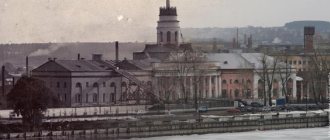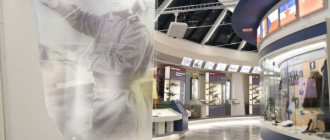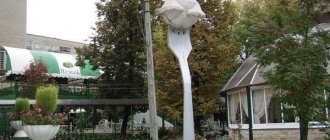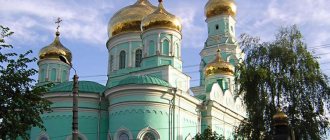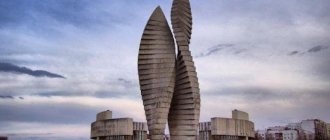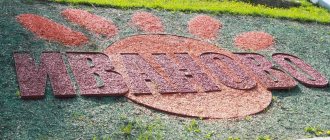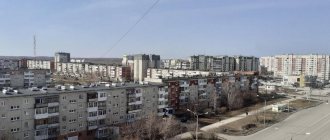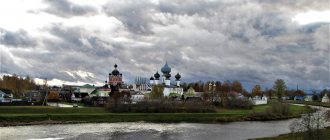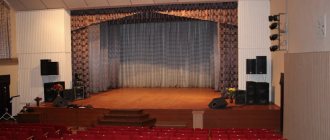Izhevsk is the administrative center of Udmurtia and is considered one of the largest industrial cities in the Volga region and the Urals. Izhevsk was founded in 1760, when the construction of the Izhevsk ironworks, a dam and a settlement on the banks of the Izh River began. Until 1918, it was called the Izhevsk plant. At the end of the Soviet empire, for three years he bore the name Ustinov.
In 1807, major changes occurred in the development of the city. On the site of the ironworks, which was seriously damaged after the attack by Emelyan Pugachev in 1774, an arms factory was founded. Thanks to this, today Izhevsk is considered one of the two weapons capitals of Russia. In the city in 1948, industrial production of the most famous and popular small arms in the world, the Kalashnikov assault rifle, began. Izhevsk has the title of cultural capital of the Volga region (2004), the most comfortable urban settlement in the country (2010), and city of labor glory (2011). In 1979 he was awarded the Order of the October Revolution.
The main elements of the coat of arms and flag of the city of Izhevsk are unclenched pincers, a vertical arrow, a shield and rowan branches with berries. They personify the trinity of nature, man and production activity. City Day in Izhevsk is celebrated on June 12 (established by the City Charter).
Natural living conditions
Izhevsk is located in the East of the East European Plain, on the Izh River, between the Kama and Vyatka rivers.
The city has an artificial reservoir (pond) with an area of 2.2 thousand hectares.
Time zone - plus 1 hour relative to Moscow time.
The climate here is temperate continental, its main parameters are as follows:
- average annual temperature - plus 3 Cº;
- seasonal soil freezing - 1.7 m;
- the average temperature of the coldest month (January) is minus 12.4 Cº;
- the average temperature of the hottest month (July) is plus 19 Cº;
- absolute temperature minimum - minus 47.5 Cº;
- absolute temperature maximum - plus 37 Cº,
- annual precipitation is 511 mm.
Typically, the temperature in the city is 0.6-0.8 Cº higher than in its suburbs. Most days of the year southwest winds blow in Izhevsk, although strong gusty winds, storms and hurricanes are rare. The most precipitation usually falls in August (67 mm). The city is located on a hilly plain, on three watershed areas.
Popular message topics
- Life and work of Tyutchev
Fyodor Ivanovich Tyutchev was born on November 23, 1803 in the village of Ovstug, Oryol province. He was the second child in the family; he had an older brother, Nikolai, and a younger sister, Daria. - Tree of Life
The tree of life is a mythological symbol of most peoples. In particular, the Slavs treated the tree of life with respect, associating it with the center of the universe. - Creativity of Arkady Averchenko
A.T. Averchenko was born in Sevastopol on March 15, 1880. He was a satirist, playwright and humorist. From birth, he had health problems, namely eye disease, and this prevented him from getting
Ecology of Izhevsk
The environmental situation in Izhevsk is not fundamentally different from other industrial cities in the country. The total volume of emissions into the atmosphere from stationary sources in the republic in recent years is 172 thousand tons. At the same time, emissions of pollutants from road transport amount to about 140 thousand tons. According to data from the traffic police, the increase in emissions from cars will increase; in 2013 alone, the number of cars increased by 3.4%.
Thanks to environmental measures in the city and the republic, the amount of captured and neutralized pollution from stationary sources is increasing (almost 4 times in 2013). The volume of discharge of poorly treated wastewater is reduced. Unauthorized landfills have a negative impact on the city's ecology, especially if they burn. In this case, they are a source of dioxides and sulfur dioxide.
Main denominations
Izhevsk, whose population is not only multinational, but also multi-religious, is one of the most striking examples of religious tolerance in Russia.
The largest religious community in the city is the Orthodox, and in Izhevsk itself the residence of the Metropolitan of Izhevsk and Udmurt has long been located, whose place is currently occupied by Metropolitan Nikolai.
The second largest community is Muslims. The first mosque appeared in the city during the times of the empire. Currently, there are three similar institutions operating here, in addition, the Regional Spiritual Administration of Muslims conducts educational activities in the city.
In addition to the two main ones, representatives of such religious movements as Buddhists, Protestants, Old Believers, and Mormons operate quite successfully in Izhevsk.
Population of Izhevsk
In 2015, the number of residents of the republican capital is estimated at 642 thousand people. The dynamics of the city's population growth since its founding are as follows:
- 1760 - 200 people;
- 1780 - 2 thousand people;
- 1917 - 40 thousand people;
- 1939 - 176 thousand people;
- 1970 - 422 thousand people;
- 1991 - 647 thousand people;
- 2015 - 642 thousand people.
In terms of population, Izhevsk is one of the twenty largest cities in the country. More than 42% of the region's residents are concentrated there. There is also an agglomeration in which more than 950 thousand people live. The share of the Russian population in the administrative center of the subject is 68.8%. The number of Udmurts and Tatars is significant, 14.8% and 8.9%, respectively. The share of other nationalities does not exceed 7.5%. In general, the number of nationalities exceeds a hundred.
Flag
The flag of Izhevsk is made in the form of a rectangular panel. It is divided into two parts vertically: azure and white. Aspect ratio – 1:2. They depict elements of the city's coat of arms. Their width is 1/4 of the length of the flag, their height is 1/3 of its length.
The artistic composition was approved on April 21, 2000 and entered into the State Heraldic Register of the Russian Federation under No. 631.
Famous people
The lives of many famous people are connected with Izhevsk, but, of course, the most famous of them is Mikhail Kalashnikov. His brainchild, the machine gun of the same name, can even be seen on the flags of a number of countries. Among other celebrities of the city and the republic, the following personalities can be noted:
- Pyotr Shuvalov, count, founder of the city, famous statesman of the country;
- Grigory Vereshchagin, ethnographer;
- Vladimir Korolenko, famous human rights activist;
- Dmitry Zelenin, ethnographer;
- Hermann Weber, motorcycle designer;
- Alexander Belyanin, full Knight of St. George;
- Hugo Schmeisser, small arms designer;
- Ivan Bodalev, merchant, builder and philanthropist;
- Gennady Nikonov, weapons designer;
- Lyudmila Glazova, actress;
- Valery Medvedtsev, biathlete, Olympic champion;
- Anton Sychev, swimmer;
- Ivan Tcherezov, biathlete;
- Maria Gorban, actress.
Economy of the region and the city of Izhevsk
It is believed that Udmurtia has the largest concentration of enterprises in the military-industrial complex. Industry and diversified agricultural production are developed in the republic. The region also has oil reserves, which are being extracted and processed. There is a powerful energy complex, consisting mainly of thermal power plants. In the north and west of the republic, logging is carried out; there are enterprises for wood processing, production of furniture and house-building structures. A nuclear industry enterprise is located in Glazov.
Izhevsk itself is known for its developed mechanical engineering and the production of high-quality steel. The city produces weapons and military equipment, small arms (hunting and rifled weapons), instrument making and the food processing industry. Industry employs 31.7% of the city's working population. The city has a low unemployment rate; at the beginning of 2015 it was 0.71%. There are branches of federal-level banks here, and there are foreign financial institutions.
The city's retail network consists of 2,300 retail outlets, 438 catering establishments and four markets. The leading positions are occupied by large chain stores of federal-level companies (Lenta, Auchan, Eldorado, etc.). There are 31 socially oriented trading enterprises. There are 21 fairs for the sale of agricultural products on an ongoing basis. Online stores are actively operating in the city market, offering a full range of consumer goods. The hotel business is well developed (52 hotels).
Izhevsk is considered a major transport hub, located at the intersection of air, rail and road routes. Buses, trolleybuses, and trams run around the city. There is an intra-city water bus.
Sights of the capital of Udmurtia
Izhevsk is rich in cultural and architectural sites. There are many cultural attractions and monuments here.
Architectural landmarks
The architectural attractions of Izhevsk are temple buildings, buildings and monuments associated with weapons production.
St. Michael's Cathedral
St. Michael's Cathedral is a functioning Orthodox church in Izhevsk, built in 2007 in honor of the Archangel Michael. The height of the structure is 67 meters. Architectural style: pseudo-Russian and neo-Byzantine.
Previously, the Trinity Chapel of the factory cemetery was located on this site. In 1784 it was rebuilt into the Trinity Church, but in 1810 it burned down in a fire. In 1855, a large stone chapel was built here. Almost 20 years later, it was decided to rebuild the new St. Michael’s Chapel into a temple. At the beginning of the 20th century, when churches were destroyed and closed, St. Michael's Church was also sealed. For some time there was a local history museum here, but then it was destroyed. Construction of the modern cathedral began in 2004.
Information for tourists:
- address: Red Square (Oktyabrsky district);
- exact coordinates: 56°50′58″N 53°12′19″E;
- official website: https://xn--90ajfzbmd.xn--p1ai;
- the schedule of services is on the official website;
- the entrance is free.
On August 5, 2007, the main altar, dedicated to the Archangel Michael, was consecrated by Patriarch Alexy II, who performed the first liturgy in the temple in the presence of the President of Udmurtia Alexander Volkov and other officials
Alexander Nevsky Cathedral
Alexander Nevsky Cathedral is an Orthodox church that has been a cathedral since 1994. The project was developed by the architect A. Zakharova and built in 1823. In the first half of the 20th century, the temple was closed, and then the building was used as a cinema. In 1990, the cathedral was returned to believers.
The history of the construction of this temple is interesting. In 1810, during a severe fire, the Elias Church was also damaged. The Izhevsk plant decided to build a new temple to replace the one that burned down, and the architect was factory employee Dudin. According to his project, the church was supposed to become beautiful and pompous, so the plant management ordered the project to be adjusted. The completed church was modest and outwardly ascetic, but a year after its opening it was visited by Alexander I.
Information for tourists:
- address: M. Gorky Street (between Lenin, Krasnaya and Sovetskaya streets);
- exact coordinates: 56°50′38″N 53°12′04″E;
- official website: https://alnevsobor.ru;
- Opening hours: daily from 7:00 to 19:00;
- the entrance is free.
The design of St. Andrew's Cathedral in Kronstadt was used as a model for construction
Main building of the arms factory
The main building of the Izhevsk plant is the central building of the industrial complex. It was recognized as an architectural monument in 1995. This building was built in 1815, and the project was developed by S. E. Dudin (student of A. D. Zakharov, 14th grade artist). Over the course of several years, the building was completed and supplemented: outbuildings appeared, chimes were installed, etc. By the 21st century, the federal facility fell into disrepair, and in 2011 it began to be restored. Unfortunately, the restoration work did not give the desired result; now another restoration is planned.
In total, the complex includes 6 buildings, and its total area is 21,045 m2. Over the years it was destroyed and suffered various accidents. In 1834, the tower of the main building collapsed during a fire. It was completely restored by 1838.
Information for tourists:
- address: Deryabina proezd, 3;
- exact coordinates: 56°50′41″N 53°11′09″E;
- You can only view the attraction from the outside;
- Inspection is free and possible at any time.
The construction of the main building of the arms factory cost the state 1.7 million rubles
Monument "Friendship of Peoples"
The Friendship of Peoples monument was erected in 1972. The opening of the monument was timed to coincide with the 400th anniversary of the republic’s entry into Russia. The height of the structure is 46 meters. The pylons were created by Promstroytrest, and the high reliefs were created by the Art Fund, S. Kuzmin and A. Burganov. Initially, the pylons were planned to be of a higher height, and on both sides the structure was to be supported by 2 more steles decorated with mosaics. However, there was not enough money in the state budget to implement the idea. “Friendship of Peoples” was called a symbol of the city and the republic, so there are always a lot of people here. Now the structure is illuminated after dark.
My friend Maxim now lives in Udmurtia. He visited Izhevsk several times, so he could not ignore this attraction. Maxim said that local residents long ago created a folk sign. It is believed that if you stand facing the monument and ask a difficult question, an unspoken answer will come. Allegedly, a person must understand what he should do.
Information for tourists:
- the object is located on the shore of Izhevsky pond;
- exact coordinates: 56°51′08″N 53°11′49″E;
- you can come to the monument at any time;
- visiting the monument is free.
During the design process, the artists drew a sketch of the monument in oil on a huge canvas - it turned out to be a “fitting model”, it was lifted above the ground using a helicopter, officials looked at it from the ground and then they finally approved the sketch
Cultural sites of Izhevsk
The main cultural attractions of Izhevsk are city theaters and museum objects.
Russian Drama Theater
The Russian Drama Theater of Izhevsk appeared in 1935. At first, the theater troupe consisted of artists from Moscow and provincial theaters. And the first production of the group was the play “Aristocrats”. The performances “Masquerade”, “Dead Souls” and “Three Sisters” were also among the first to be presented to the Izhevsk public. In 1941, the old theater building burned down, some actors gave up their dramatic careers, and then the war began. The troupe did not have a building or the necessary props, so performances had to be staged in hospitals and factories.
In 1946, the theater was given a new building, built according to the design of V. Tishin, accommodating almost 800 spectators. In 1961, the institution was named after V. G. Korolenko. All subsequent years the theater operated on a permanent basis. Now the theater is directed by Vladimir Safronov, and recent productions include such performances as “Mary Stuart”, “The Players”, “The Lady of the Camellias”, etc.
Information for tourists:
- address: Maxim Gorky street, 71;
- exact coordinates: 56°50′38″N 53°11′58″E;
- official website: https://dramteatr18.ru;
- Opening hours: daily from 9:00 to 20:00;
- Ticket prices depend on the production.
Since the fall of 2010, the main director of the theater is Viktor Prokopov
Museum named after Kuzebay Gerd
The Kuzebay Gerd Museum is a local history exhibition founded in 1920. At first, the museum was located in a church, and the director was A. M. Filippov. The museum changed its name many times, in different years - Izhevsk Regional Museum, Museum of the Votsk Autonomous Okrug, etc. The current name of the institution was assigned in 2000. Kuzebay Gerda was an Udmurt poet and playwright, prose writer and public figure, and from 1925 to 1926 Gerda was the director of this museum.
The exhibition changed its location many times, since the museum did not have its own building. Over the years, he occupied the premises of the Alexander Nevsky and St. Michael's Cathedrals, as well as house No. 23 on Karl Marx Street. The museum moved to the Arsenal building of the arms factory in 1970. The main exhibition consists of samples of weapons, national costumes, peasant utensils and documents. The museum also has a collection of rare books (5,700 units).
Information for tourists:
- address: Kommunarov street, 287;
- exact coordinates: 56°51′12″N 53°12′57″E;
- official website: https://nmur.ru;
- Opening hours: Tuesday and Wednesday - from 10:00 to 18:00, Thursday - from 10:00 to 21:00, from Friday to Sunday - from 10:00 to 18:00;
- entrance fee: 100 rubles.
In 1975, the Arsenal building was recognized as a monument of federal significance, and in 1987–1994 the building was restored
Historical places of Izhevsk
The architectural sights of the city are also historical monuments, since each building is associated with the history of the capital and the republic as a whole. The striking historical sights of Izhevsk are the Kalashnikov Museum and St. Michael's Column.
Kalashnikov Museum
The Kalashnikov Museum is a museum and exhibition complex opened in 2004. At first it was a small municipal museum named after the designer Kalashnikov. And the complex designed by P. Fomin began to be built after the opening of the exhibition. The opening was timed to coincide with the 85th anniversary of M. T. Kalashnikov. The exhibits of the museum are samples of weapons - from the very first to the modern ones ever produced by the Izhevsk plant. In addition, here you can familiarize yourself with the history of the development and implementation of each sample.
In 2009, the Kalashnikov Museum was awarded the honorary badge “For active work in the patriotic education of citizens of the Russian Federation.”
Information for tourists:
- address: Borodina street, 19;
- you can get to the museum by trams No. 1, 2, 4, 9 or buses No. 111 and 131 (stop “Ulitsa Krasnogeroyskaya”);
- official website: https://museum-mtk.ru;
- Opening hours: Tuesday to Sunday - from 11:00 to 19:00;
- entrance fee: 100–150 rubles.
The main thing that distinguishes the Kalashnikov Museum is the presence of a shooting range where anyone can try out weapons (albeit for an additional fee)
St. Michael's Column
St. Michael's Column is a monument erected by decree of Emperor Nicholas I. The column was installed in memory of Prince Mikhail Pavlovich, who died in 1849. The monument was erected in 1852, since then the residents of Izhevsk began to venerate Archangel Michael, who was considered the heavenly patron of the prince. The height of the column was 20 meters.
The column, not inferior in size to its St. Petersburg counterparts, was destroyed in 1918 by the Bolsheviks. It is known that there were cast iron cannons around the monument, but where they are now is unknown. The object was restored in 2007. Outwardly, it resembles the previous one, but its height has been reduced to 19 meters, and its tiers are folded into a cone. The sculpture of an angel on top of the column was created by sculptor P. Medvedev.
Information for tourists:
- address: square opposite Sovetskaya Street, 1;
- exact coordinates: 56°50'38″N 53°11'55″E;
- You can explore the attraction at any time and for free.
The Mikhailovskaya Column is located in the courtyard of the State Russian Drama Theater, opposite the plant; a sign was again installed on it, which reads: “The column was installed in honor of Grand Duke Mikhail Pavlovich on November 8, 1852. Restored on November 4, 2007"
Natural attractions
The main natural attractions of Izhevsk are city gardens, public gardens and the famous Izhevsky pond.
Izhevsky Pond
Izhevsky Pond is an artificially created reservoir into which 4 rivers and a stream flow. The reservoir was created in 1760 on the Izh River. The purpose of construction was to create draft power for the Izhevsk plant. To do this, they dug trenches and made a frame from logs. Serfs were invited to work. The reservoir was finally dammed by 1763. The water body has repeatedly suffered accidents, including due to fires - the water wheels and fences were made of wood. The total area of the pond is 24 km2, and the average depth is 3.5 meters. Now the reservoir is used for small navigation, urban water supply and local history research. Izhevsk residents visit unorganized beaches in the warm season.
Maxim said that many legends are associated with this reservoir. The first of them said that many millions of years ago mammoths and primitive people lived here. Rumors appeared after archaeologists found mammoth teeth and bones at the bottom of the pond. Local residents also say that the Bolsheviks threw unwanted monuments, statues and other evidence of “unreasonable luxury” into this reservoir. Recently, local historians have proven that most of these stories have scientific confirmation, but all this attracts the attention of townspeople to the pond.
Information for tourists:
- the pond is located in the Kirov Park area;
- exact coordinates: 56°52′55″N 53°07′58″E;
- You can visit the pond at any time and for free.
A popular place for walks for Izhevsk residents is the embankment of the city pond.
Gorky Garden
The Gorky Summer Garden was created in 1857. The garden, which is now a popular attraction in Izhevsk, was once supposed to surround the state-owned “General's House”. This building was built 3 years before the first trees were planted, the author of the project was I.P. Kokovikhin. After the 1917 revolution, this place became available to all residents. At the beginning of the 20th century, the Summer Theater was built here, which is why the garden is now called the Summer Garden.
In 1928, the garden was named in honor of M. Gorky, but the writer’s portrait could not be preserved. But there is a monument to Gorky here, and a statue of Stalin (1939) was installed in the center of the garden Rotunda. After this, swings, carousels and other attractions were installed. In 2015, the garden began to be reconstructed. You can come here for a walk, to attend a festive event, or just for fresh air.
Information for tourists:
- the garden is located on the shore of Lake Izhevsk;
- exact coordinates: 56°50′49″N 53°11′55″E;
- official website: https://www.izh-ls.ru;
- Opening hours: daily from 10:00 to 22:00;
- There is no entrance fee, you only need to pay for tickets to the attractions.
The Gorky Summer Garden is interesting not only for its nature and attractions, but also for its numerous sculptures
Investments
Izhevsk is a steadily developing city, so a lot of investment projects are being implemented here in various fields of activity:
- residential construction (mainly multi-family housing);
- construction of a plant for the production of cable joints;
- reconstruction of sections of heating mains;
- reconstruction of overhead power lines;
- modernization of facilities to create production of the LADA2191 car;
- creation of production of springs with increased service life;
- expansion of steel radiator production;
- increasing the production of sporting and hunting weapons;
- creation of specialized production of gyroscopes;
- creation of lines for the production of insulating tapes and acrylic adhesive tapes;
- creation of production for anodizing aluminum profiles.
In addition, there are a number of projects that could be implemented if additional funding is found:
- expansion of paint and varnish production;
- creation of the Scientific and Production Center “Cryogenic Technologies”;
- low-rise microdistrict;
- creation of a biotesting and biomonitoring laboratory;
- remediation of solid waste landfill;
- creation of production of light-emitting diodes;
- technical re-equipment of the boiler room.
Enterprises of Izhevsk
OJSC Concern Kalashnikov is a diversified joint-stock company, the main activities of which are the manufacture and testing of small arms (combat, sports, hunting), guided high-precision projectiles for artillery, guns for aviation, machine tools, tools and test mechanisms. In the near future, the company plans to release branded clothing of the same name. The number of employees is more than 4.5 thousand people.
OJSC Izhevsk Mechanical Plant produces 86% of all small arms in the country (civilian and service), packaging and oil and gas equipment, precision steel castings, medical equipment (pacemakers), electrical tools, automobile compressors. The number of employees is more than 7 thousand people.
LLC Poultry Farm Varaksino is the 4th poultry farm in Russia and the largest egg producer in Udmurtia. This is a closed-cycle factory, covering all stages from incubation to finished products. The volume of production, including branches, is 663 million eggs per year.
OJSC Izhevsk Electromechanical is a defense industry enterprise, part of the Almaz-Antey concern. Manufactures and services the Saman-M1 target complex and the Tor-M2E air defense system. The civil sector is represented by various climate control equipment.
OJSC Izhevsk Moto produces special equipment for military needs, radio relay, satellite and operational communications equipment, energy-saving equipment, parts and components for cars.
Construction in Izhevsk
The central object of the city, shaping the appearance of the city, is Izhevsky Pond. The capital of the republic itself is essentially a factory city. Izhevsk is developing not only through the construction of new districts, but also by improving the quality of life and the level of infrastructure of existing territories. In particular, over the past few years, a new Cherry Square has been organized, the area around the city administration has been landscaped, and there is a project for a park for cyclists.
A roundabout on Liebknecht and Pushkinskaya streets was built. Work is underway to develop the concept of the Central Square.
There are plans for large-scale development of housing complexes. In 2019 alone, about 315 thousand square meters of housing were commissioned. These are mainly apartment buildings, accounting for about 88% of the built area. The main ways of development of the capital of the republic today are:
- development of a central architectural ensemble along the main directions to the south, north and east with the construction of business and (or) public centers;
- continuation of the formation of construction sites in the center;
- reconstruction and improvement of meridional and latitudinal streets;
- restoration of cultural heritage buildings;
- transfer of transit traffic beyond the borders of Izhevsk;
- changes in the purpose of industrial areas for residential and public development;
- systemic improvement and development of the Izhevsky Pond area;
general information
Izhevsk traces its glorious history back to 1760 and acquired city status in 1918. Today it is a major administrative, industrial, scientific, educational and cultural center of the Volga region and the Urals. It bears the honorary title of City of Labor Glory and is considered the “weapons capital” of Russia. The architectural ensemble of the city harmoniously combines ancient buildings of the 19th – early 20th centuries, impressive churches, modern buildings and industrial enterprises. The visiting card of the city and a symbol of the revival of the spiritual life of the region is St. Michael's Cathedral, built in 1907 and restored to its historical appearance a hundred years later. Izhevsky Pond is one of the most picturesque places in the city and is recognized as the largest artificial reservoir in Europe. The city has a lot of interesting monuments, sculptures and museums, several theaters, cinemas, a zoo, a circus and entertainment venues. About thirty cultural projects of international and federal scale are implemented here annually. Mass events are regularly held in the open areas of the city: the opening of the New Year tree, City Day, the “Broad Maslenitsa” holiday, “Red Festival”, “Flower Festival”, Tatar “Sabantuy” and others.
Cost of new buildings
Depending on the area, number of storeys, material and class of construction, the cost on the primary market of Izhevsk ranges from 50 to 60 thousand rubles per square meter.
Let's consider the average sale price depending on the number of rooms
- A one-room apartment will cost residents of Izhevsk around 2,296,634 rubles;
- A two-room apartment can be found for RUB 3,274,192;
- The cost of a three-room apartment ranges from 4,664,424 rubles.
Since most of the residential real estate put into operation belongs to the economy class, we bring to your attention the average market prices for the city districts. For convenience, we will arrange the areas in ascending order of price per square meter in a new building:
- Leninsky District offers apartments with an average price of 50 thousand rubles per square meter. The cheapness is due to the presence of a large number of industrial enterprises.
- Pervomaisky district is filled with housing costing from 55 thousand rubles per 1 m2. This price order can be found in all six residential neighborhoods.
- Ustinovsky district is a densely populated area. Its territory is the smallest in area among all the districts. Despite the dense development and the smallest amount of green territory, the average cost per square meter in a new building does not fall below 56 thousand rubles.
- The Industrial District finishes with the highest price in January for 1 m2 at 58 thousand rubles
City districts
Initially, in 1934, there were three districts in Izhevsk. As a result of decisions made by regional authorities, the administrative division has undergone various changes over the years. Their result is the division of the settlement into five districts:
- Ustinovsky (137 thousand people);
- Oktyabrsky (136 thousand people);
- Pervomaisky (126 thousand people);
- Leninsky (125 thousand people);
- Industrial (119 thousand people).
According to 2015 data, the Ustinovsky district is considered the largest in terms of the number of inhabitants, the most densely populated and at the same time the smallest in area (24.3 sq. km). This is due to the dense development of apartment buildings and the small area of green areas. Formed in 1987.
Along the border of the two largest districts of the city, Leninsky (130 sq. km) and Oktyabrsky (87.8 sq. km), is Izhevsky Pond. The territory of the current Leninsky district is the place where the construction of an ironworks and dam began in 1760. It is considered the historical center of Izhevsk. The formation of the Industrial District is mainly associated with the creation. Mechanical engineering, food and light industry, and trade are developed in the Pervomaisky district.
Ways to solve the problem
Naturally, there is no single solution to the problems associated with the deteriorating demographic situation, but in the conditions of Izhevsk you can take advantage of the following points.
Firstly, local authorities should focus on ideological propaganda of family values and the enormous role of motherhood in the formation of every person.
Secondly, it is necessary to improve the healthcare system, since the gradual aging of the population will inevitably lead to an increase in visits to doctors.
Thirdly, Izhevsk, whose population in Soviet times was distinguished by high scientific and industrial potential, should strive to attract people with high educational potential. The basis for this should be an increase in the level of educational services.
Buildings and constructions
The tallest building in the city is considered to be a business height of 70 meters, consisting of 20 floors (including 2 technical ones). A helipad is mounted on its roof on special supports. The History Museum is located in the oldest building in Izhevsk (former money storeroom), it was built in 1807. The tallest building in the capital of Udmurtia (178 meters) is the television tower on Pesochnaya Street.
The very first bridge in the city is considered to be the Long Bridge. It was built in 1839 and reconstructed in 1960. This is the most important bridge located within the city, connecting its Nagornaya and Zarechnaya parts. The Petrovsky shopping and entertainment complex is the largest in Izhevsk and Udmurtia, its area is 50 thousand square meters. m (of which 35 thousand sq. m are retail space).
The most historically significant structure for the city can be called the Factory Dam. Its commissioning took place in 1763. Initially, its length was 570 meters and its width was 27.7 meters. In subsequent years, it was repeatedly modernized and reconstructed, thanks to which the dam became wider, longer and received a road surface.
Thanks to the construction of the dam in Izhevsk, its main artificial reservoir, the Izhevsky Pond, appeared. The area of its mirror is 24 sq. km, the greatest depth is 12 m. Currently, it is used for water intake (drinking and process water) and passenger intracity shipping.
How to get to Izhevsk?
For those who prefer to travel to the Udmurt capital by train, it is important to know that in Moscow passenger trains depart from the Kazansky railway station. Travel time – from 16 hours 43 minutes. until 20:50 Trains arrive in Izhevsk at a modern station located on the street. Druzhba, 16. In the neighboring building (house 18) there is a post office (index - 426 960) and a sorting shop.
Planes depart to Izhevsk from three capital airports: Vnukovo, Sheremetyevo or Domodedovo. Travel time without transfers is from 1 hour 35 minutes. up to 2 hours 05 minutes In Izhevsk, the airport is located 16 km from the central quarters of the city. Tourists get to hotels by taxi or bus No. 331.
